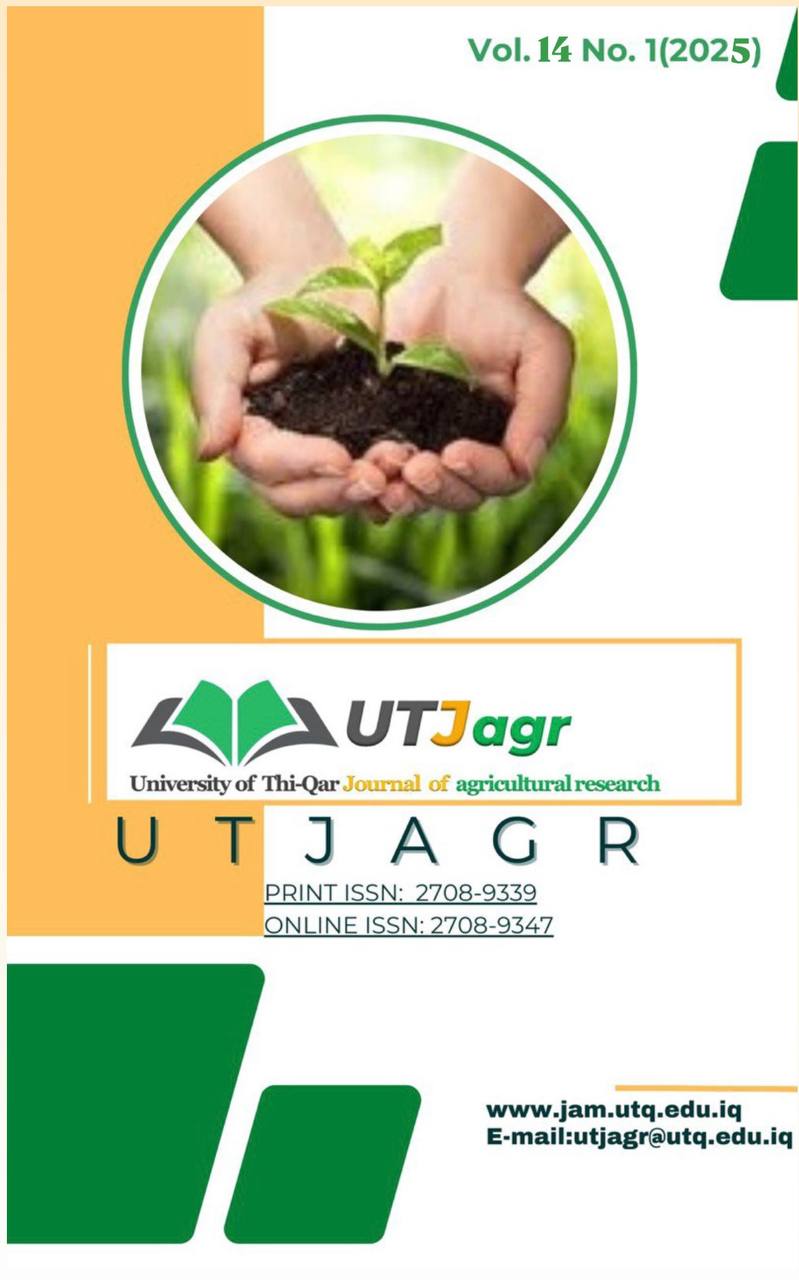Spatial and temporal distribution of heavy elements in the roadsides of Basrah Government.
DOI:
https://doi.org/10.54174/wt647e21Keywords:
pollution, soil, accumulation, heavy elements, cadmiumAbstract
Since heavy element pollution of soil has become a global issue for human health and food security concerns, the purpose of this study is to determine the levels of heavy element pollution by examining the effects of vehicle traffic on the roads and the toxic waste it generates in the streets of Basrah Government in southern Iraq. The core samples were collected randomly from October 2022 to April 2023 for the purpose of measuring the concentrations of heavy elements (manganese - lead - cadmium - chromium - zinc - iron - nickel) in exchangeable and residual phases in roadsid soil, using the flame atomic absorption spectrometer (AAS). Pollution indicators: geoaccumulation index (I-geo) , Contamination factor (CF) and Enrichment factor (EF) , were also measured .
The results of the highest concentrations of heavy elements (Ni, Fe, Zn, Cr, Cd, Pb, Mn) in the Exchangeable phase of soil were (113.45,2462.16,69.24,204.87,3.49,842.05,1407.00 μg/g dry weight respectively. While the lowest concentration was 14.82,598.58,8.96,72.88,0.84,5.14,45.11) μg/g dry weight respectively. Whereas the highest concentration in residual phase of soil was 94.45 ,3340.87 ,58.35 ,318.59 ,2.74, 681.12 ,222.44 μg/g dry weight respectively. While the lowest concentration was (18.30,902.32,12.04,40.69,0.54,14.72,6.53 (μg/g dry weight respectively. Assessment of heavy elements pollution, using pollution indexes registered that the annual average of study station with (I-geo) factor ranged from moderately polluted to polluted, especially with Pb, Ni and Cr. Also, contamination factor indicated CF considerable contamination to very high contamination especially with Pb and Ni . Enrichment factor( EF ) indicated very severe enrichment to extremely severe enrichment especially with, Pb, Ni and Cr . pollution of the study area by heavy elements depended of indexes factors in the order of Pb > Ni > Cr > Cd > Mn > Zn > Fe .
Downloads
References
Abdulnabi, Z. A., Altememi, M. K., Hassan, W. F., Al-Khuzaie, D. K. K., & Saleh, S. M. (2019). Assessing of some toxic heavy metals levels and using geo accumulation index in sediment of Shatt Al-Arab and the Iraqi Marine region. Baghdad Science Journal, 16(2), 323-331.
•Adimalla, N. (2020). Heavy metals contamination in urban surface soils of Medak province, India, and its risk assessment and spatial distribution. Environmental Geochemistry and Health, 42(1), 59-75.
•Agyeman, P. C., John, K., Kebonye, N. M., Borůvka, L., Vašát, R., Drábek, O., & Němeček, K. (2021). Human health risk exposure and ecological risk assessment of potentially toxic element pollution in agricultural soils in the district of Frydek Mistek, Czech Republic: a sample location approach. Environmental Sciences Europe, 33, 1-
•AI-Saad, H. T., Kadhim, A. H., & AI-Hejuje, M. M. (2022). Heavy Elements in Soil of West Qurna-1 Oil Field in Basrah Governorate, Southern Iraq. Journal of pollution, 4, 102.
•Aktar, M. W., Sengupta, D., & Chowdhury, A. (2009). Impact of pesticides use in agriculture: their benefits and hazards. Interdisciplinary toxicology, 2(1), 1.
•Aktaruzzaman, M., Chowdhury, M. A. Z., Fardous, Z., Alam, M. K., Hossain, M. S., & Fakhruddin, A. N. M. (2014). Ecological risk posed by heavy metals contamination of ship breaking yards in Bangladesh.
•Al-Asadi, W. M., & Al-Maliki, H. H. N. (2022). The Assessment of Soil Contamination for Some of Basrah province Regions Using ICP-GCMS Technology. Marsh Bulletin, 17(2(:
•Al-Busaidi, A., Shahroona, B., Al-Yahyai, R., & Ahmed, M. (2015). Heavy metal concentrations in soils and date palms irrigated by groundwater and treated wastewater. Pakistan Journal of Agricultural Sciences, 52(1).
•Al-Haidarey, M. J. S. (2009). Assessment and sources of some heavy metals in Mesopotamian marshes. Unpublished PhD Thesis, College of Science for Women, University of Baghdad, Iraq.
•Alharbi, T., & El-Sorogy, A. S. (2022). Risk assessment of potentially toxic elements in Agricultural soils of Al-Ahsa Oasis, Saudi Arabia. Sustainability, 15(1), 659.
•Al-Hejuje, M. M. (2014). Application of water quality and pollution indices to evaluate the water and sediments status in the middle part of Shatt Al-Arab River. College of Science, University of Basrah.
•Alhello, M. A., Al-Khuzie, D. K., Saleh, S. M., Alhello, A., Alsaad, H., & Hassan, W. F. (2020). Heavy Metals Indicies In Shatt Al-Arab River, Basrah Province, Iraq. I: Sediments. Poll. Res, 39, S14-S19.
•Al-Hemidawi, F. N., Hameed, A., & Al-Saad, H. T. (2020). Heavy metals, Sediments, Al-Delm Heavy Metals in Sediments of Al-Delmaj Marsh, Al-Qadisiya/Wasit Governorates–Iraq. Al-Qadisiyah Journal of Pure Science, 25(2), 5-12.
•Al-khafaji, S. J., & Jaafar, S. W. (2023). Heavy Metals Pollution Assessment in Soil of Al-Zubair Area, Southern Iraq. Iraqi National Journal of Earth Science, 23(2), 91-104.
•Al-Sheraefy, R. M., & Al-Mallah, A. Y. (2023). Spatial distribution of heavy metals in the soil of different area at left bank in Mosul City, Iraq: Part 2. Iraqi National Journal of Earth Science (INJES), 23(1), 132-153.
•Al-Sheraefy, R. M., Al-Mallah, A. Y., & Hussien, A. K. (2023). Spatial Distribution of Heavy Metals in the Soil of Different Areas at Right Bank in Mosul City, Iraq: Part 1. Iraqi Geological Journal. Vol. 56 (1C), pp. 40-61.
•Beinabaj , S. M .H; Hydaryan , H ; Aleii , H.M . & Hosseinzadeh ,A.(2023 )Concentration of heavy metals leachate, soil, and plants in Tehrans landfill: Investigation of the effect of landfill age on the intensity of pollution.Jornal homepage: www.cell.com/heliyon.
•Beinabaj, S. M. H., Heydariyan, H., Aleii, H. M., & Hosseinzadeh, A. (2023). Concentration of heavy metals in leachate, soil, and plants in Tehran’s landfill: Investigation of the effect of landfill age on the intensity of pollution. Heliyon, 9(1).
•Cetin, M., Aljama, A. M. O., Alrabiti, O. B. M., Adiguzel, F., Sevik, H., & Zeren Cetin, I. (2022). Using topsoil analysis to determine and map changes in Ni Co pollution. Water, Air, & Soil Pollution, 233(8), 293.
•Chen, B., Liang, X., Xu, W., Huang, X., & Li, X. (2012). The changes in trace metal contamination over the last decade in surface sediments of the Pearl River Estuary, South China. Science of the total environment, 439, 141-149.
•Christoforidis, A., & Stamatis, N. (2009). Heavy metal contamination in street dust and roadside soil along the major national road in Kavala's region, Greece. Geoderma, 151(3-4), 257-263.
•Civeira, G. (Ed.). (2019). Soil Moisture. BoD–Books on Demand.
•De Jonge, M., Van de Vijver, B., Blust, R., & Bervoets, L. (2008). Responses of aquatic organisms to metal pollution in a lowland river in Flanders: a comparison of diatoms and macroinvertebrates. Science of the Total Environment, 407(1), 615-629.
•Doabi, S. A., Karami, M., Afyuni, M., & Yeganeh, M. (2018). Pollution and health risk assessment of heavy metals in agricultural soil, atmospheric dust and major food crops in Kermanshah province, Iran. Ecotoxicology and environmental safety, 163, 153-164.
•Duru, S. C., Echiegu, E. A., Anyadike, C. C., Alaneme, G. U., & Okechukwu, M. E. (2024). Spatial variability of heavy metals concentrations in soil of auto-mechanic workshop clusters in Nsukka, Nigeria. Scientific Reports, 14(1), 9681.
•Duru, S. C., Echiegu, E. A., Anyadike, C. C., Alaneme, G. U., & Okechukwu, M. E. (2024). Spatial variability of heavy metals concentrations in soil of auto-mechanic workshop clusters in Nsukka, Nigeria. Scientific Reports, 14(1), 9681.
•Georgina Diallo UNICEF Europe and Central Asia at 21 2024gdiallo@unicef.org 30/7/2020 new yorke..
•Gharbi, M. A., Abdulateef, A. A., Alalwany, A. A., Mosleh Alenzy, A. F., & Shafeeq, A. F. (2024). Pollution of Some Agricultural Soils by Heavy Metals in Kubaisa Iraqi Western Desert--A Case Study. Ecological Engineering & Environmental Technology (EEET), 25(4).
•Gorbunova, N. S., Gromovik, A. I., Cherepukhina, I. V., Vladimirov, D. R., Fedotov, S. V., Jiaolong, Y., ... & Chanhua, M.(2022). Sorption capacity of organic matter to heavy metals and its use for polluted soils recover soils recover.
•Gulyás, G., Pitás, V., Kárpáti, Á., Fazekas, B., Domokos, E., & Rédey, Á. (2014). Heavy metal balance in a Hungarian municipal sewage treatment plant. Environmental Engineering & Management Journal (EEMJ), 13(8).
•Hasnine,T.;Khatun,R. ,Saadatm, A.H.M& Akter, S.(2017).Heavy metalcontamination in agricultural soil at DEPZA,Bangladesh.Environmental and Ecology Research 5(7):510-516,2017.
•Hassan, N., & Umer, M. (2022). Primary Treatment of Landfill Leachate Effects on Heavy Metal and Soil Chemical Properties in Kwashe Industrial Area in Duhok Province, Kurdistan Region of Iraq. Journal of Medicinal and Chemical Sciences, 5(1), 1-9.
•Issa, H. M., & Alshatteri, A. H. (2021). Heavy metals contamination in agricultural soils of middle basin of Sirwan (Diyala) River, East Iraq: Multivariate analysis, risk assessment, source apportionment, and spatial distribution. J. Mater. Environ. Sci, 12, 391-405.
•Ivanescu, V. (2015). Human health risk assessment posed by PCB exposure in Bucharest Area. Agriculture and Agricultural Science Procedia, 6, 453-458.
•Jaafar, R. S. (2019). The potential role of sphingomonas paucimobilis in bioremediation of soils contaminated with hydrocarbon and heavy metal: Bioremediation using Sphingomonas paucimobilis. Malaysian Journal Of Science, 48-58.
•Jiang, Z., Guo, Z., Peng, C., Liu, X., Zhou, Z., & Xiao, X. (2021). Heavy metals in soils around non-ferrous smelteries in China: Status, health risks and control measures. Environmental Pollution, 282, 117038.
• Hikon, B. N., Maina, H. M., & Joseph, A. (2023). The effect of pH on heavy metals availability on crude oil remediated and non-remediated soil, Nkeleoken Community Eleme, Rivers State, Nigeria
•Kadkhodaie, A., Kelich, S., & Baghbani, A. (2012). Effects of salinity levels on heavy metals (Cd, Pb and Ni) absorption by sunflower and sudangrass plants. Bull. Environ. Pharmacol. Life Sci, 1(12), 47-53.
•Kahdim, I. A. (2017). Determination of Heavy Metals (Pb, Cd, Zn, Cu, Ni, Co) in Street Soil of Shattrah City.
•Khan, M. A., Mehmood, S., Ullah, F., Khattak, A., & Zeb, M. A. (2017). Health risks assessment diagnosis of toxic chemicals (heavy metals) via food crops consumption irrigated with wastewater. Sains Malaysiana, 46(6), 917-924.
•Küçüksümbül, A., Akar, A. T., & Tarcan, G. (2022). Source, degree and potential health risk of metal (loid) s contamination on the water and soil in the Söke Basin, Western Anatolia, Turkey. Environmental Monitoring and Assessment, 194(1), 6.
•Li, L., Wang, Y., Yongliang, R., Weiqin, X., Qi, L., & Zhao, Y. (2012). Soil pH, electrical conductivity and their relations with availability of heavy metals in the vicinity of a lead smelting factory. Journal of Hebei Agricultural Sciences, 16(71–76), 80.
•Man, Q., Xu, L., & Li, M. (2022). Source identification and health risk assessment of heavy metals in soil: A case study of Lintancang Plain, Northeast China. International Journal of Environmental Research and Public Health, 19(16), 10259.
•Manoj, K., Kumar, B., & Padhy, P. K. (2012). Characterisation of Metals in Water and Sediments of Subarnarekha River along the Projects' Sites in Lower Basin, India. Universal Journal of Environmental Research & Technology, 2(5).
•Margni, M., Rossier, D., Crettaz, P., & Jolliet, O. (2002). Life cycle impact assessment of pesticides on human health and ecosystems. Agriculture, ecosystems & environment, 93(1-3), 379-392.
•Mishra, S., Bharagava, R. N., More, N., Yadav, A., Zainith, S., Mani, S., & Chowdhary, P. (2019). Heavy metal contamination: an alarming threat to environment and human health. Environmental biotechnology: For sustainable future, 103-125.
•Mishra, S., Lin, Z., Pang, S., Zhang, Y., Bhatt, P., & Chen, S. (2021). Biosurfactant is a powerful tool for the bioremediation of heavy metals from contaminated soils. Journal of Hazardous Materials, 418, 126253.
•Moghal, A. A. B., & Al-Shamrani, M. A. (2012). Effect of Temperature on the Heavy Metal Retention Characteristics of Semi-Arid Soils of Saudi Arabia. In GeoCongress 2012: State of the Art and Practice in Geotechnical Engineering (pp. 3949-3958).
•Padma, S., Srinivas, B., Ghanta, K. C., & Dutta, S. (2023). Bioremediation of Cr (VI) using indigenous bacterial strains isolated from a common industrial effluent treatment plant in Vishakhapatnam. Water Science & Technology, 88(11), 2889-2904.
•Rayhan Khan, M. A., Hosna Ara, M., & Kumar Dhar, P. (2019). Assessment of heavy metals concentrations in the soil of Mongla industrial area, Bangladesh. مجله مدیریت و مهندسی بهداشت محیط, 6(3), 191-202.
•Salauddin, A., & Sandesh, C. (2023). Heavy Metal Pollution of Soil and Crops in Rural Gujarat, Next to an Industrial Area: A Correlation Study. Nature Environment and Pollution Technology, 22(2), 691-698.
•Sandy, A. L., Guo, J., Miskewitz, R. J., McGillis, W. R., & Rodenburg, L. A. (2013). Mass transfer coefficients for volatilization of polychlorinated biphenyls from the Hudson River, New York measured using micrometeorological approaches. Chemosphere, 90(5), 1637-1643.
•Savci, S. (2012). An agricultural pollutant: chemical fertilizer. International Journal of Environmental Science and Development, 3(1), 73.
•Sherene, T. (2010). Mobility and transport of heavy metals in polluted soil environment. In Biological forum—an international journal (Vol. 2, No. 2, pp. 112-121).
•Sultan, M., Al-Rubaiee, M., & Abdulrahim, E. (2012). Assessment of toxic and carcinogenic elements in Dust and Soil in Baghdad city and their effects on the distribution of some diseases. Iraqi Journal of Science, 53(Remote Sensing-Conf), 167-177.
•Tall, A., Kandra, B., Gomboš, M., & Pavelková, D. (2019). The influence of soil texture on the course of volume changes of soil. Soil & Water Research, 14(2).
•Tewari, G., Srivastava, P. C., Ram, B., & Joshi, N. (2011). Transformation of added lead and nickel in different soil conditions: a comparative study. Researcher, 3, 113-119.
•Tian, G., Luo, Q., Xing, R., Zhang, J., & Li, X.( 2024) . Drought Aggravates Soil Cadmium Pollution: Insights from Nanoscale Interfacial Interaction. Available at SSRN 4697164.
•Wang, M., & Zhang, H. (2018). Accumulation of heavy metals in roadside soil in urban area and the related impacting factors. International journal of environmental research and public health, 15(6), 1064.
•Wei, R., Chen, C., Kou, M., Liu, Z., Wang, Z., Cai, J., & Tan, W. (2023). Heavy metal concentrations in rice that meet safety standards can still pose a risk to human health. Communications Earth & Environment, 4(1), 84
. • Wei, M., Chen, J., Sun, Z., Lv, C., & Cai, W. (2015). Distribution of heavy metals in different size fractions of agricultural soils closer to mining area and its relationship to TOC and Eh. In Proceedings of the World congress on new technologies, Barcelona, Spain (pp. 200-206).

Downloads
Published
Issue
Section
License
Copyright (c) 2025 Hussein Hussein Oleiwi Anber, Salwa A. Abduljaleel, Makia Mohalhul Al-Hejuje

This work is licensed under a Creative Commons Attribution-NonCommercial-ShareAlike 4.0 International License.







1.png)

